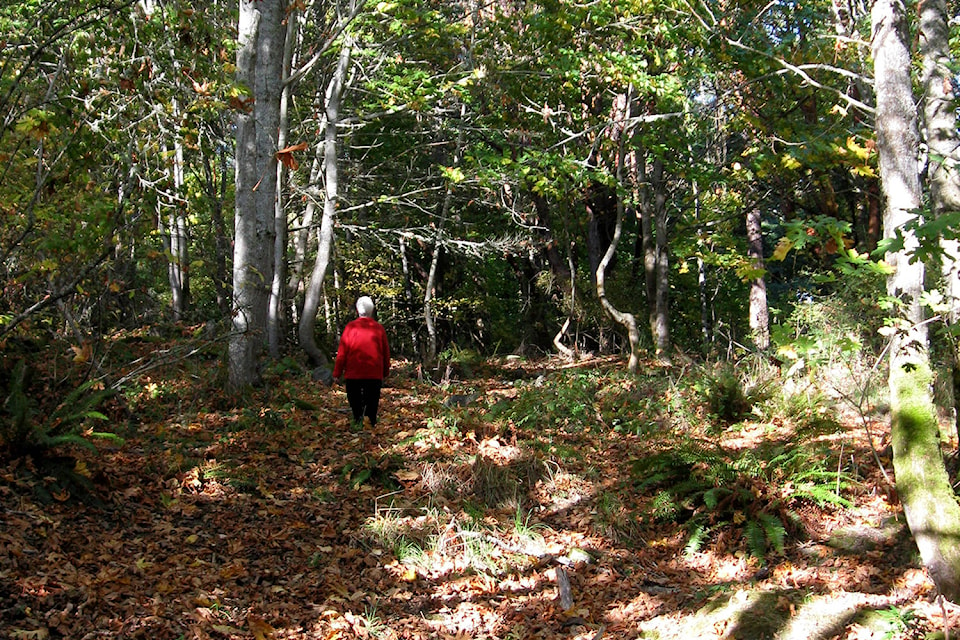The question of allowing cycling remains the central sticking issue as planning for the future of Haro Woods move forward.
Coun. Dean Murdock, who chairs SaanichB��Ԫ������ַ�s parks, trails and recreation advisory committee, said the community appears to have found B��Ԫ������ַ�good consensusB��Ԫ������ַ� around key goals of the draft plan for Haro Woods.
B��Ԫ������ַ�Those include goals about restoring the creek, supporting the urban forest of the park, providing education and encouraging stewardship of the park, and maintaining public access,B��Ԫ������ַ� he said. But Murdock said the plan B��Ԫ������ַ�cannot be silentB��Ԫ������ַ� on the issue of cycling in the park. B��Ԫ������ַ�We have to determine an appropriate way forward,B��Ԫ������ַ� he said.
Murdock made these comments as Saanich staff continue to develop a draft plan for the recreation area near the University of Victoria (UVic). The area with its mature Douglas firs has become a popular destination for walkers, joggers and cyclists, drawing users from inside and outside of Saanich. But this popularity has also caused environmental damage, while sparking conflict among users.
The draft management plan describes Haro Woods as a B��Ԫ������ַ�healthy urban forestB��Ԫ������ַ� that is a B��Ԫ������ַ�functioning ecosystem that welcomes respectful use,B��Ԫ������ַ� but the nature of this B��Ԫ������ַ�respectful useB��Ԫ������ַ� remains in dispute, with no issue more contested than the question of off-trail biking. B��Ԫ������ַ�At time of writing, the Haro Woods Advisory Group and the general public are divided on the off-trail biking issue,B��Ԫ������ַ� the draft plan reads.
Murdock said staff are currently working with the community to explore options that improve management and co-existence amongbikers, other park users and the environment.
Potential options include the creation of a biking area in a B��Ԫ������ַ�previously disturbed areaB��Ԫ������ַ� of Haro Woods, and .
Murdock said cycling has been an activity in Haro Woods long before Saanich recently acquired the property, adding it also happens on neighbouring parcels of land that the Capital Regional District (CRD) and UVic respectively own.
But this use has challenges that need to be managed, said Murdock. Different reasons attract the diverse group of cyclists, who use the woods. But their activities including ramp building have caused concerns, he said.
While Saanich could restrict or completely ban cycling in the area, Murdock predicts a ban would likely be ineffective because it would be difficult to enforce.
B��Ԫ������ַ�It can be resource-intensive to keep up with the jump and trail building which occurs regularly,B��Ԫ������ַ� he said. B��Ԫ������ַ�Staff have made every effort to avoid this becoming a confrontational issue and have been actively working with the cycling community to find a solution that balances their desires with those in the community who want to preserve and protect the environment. Finding that balance is the remaining key challenge of the planning process.B��Ԫ������ַ�
So where does Murdock stand? B��Ԫ������ַ�I can certainly appreciate the views of the park users who are concerned about the damage to the natural environment created by cyclists,B��Ԫ������ַ� he said. B��Ԫ������ַ�There is also the potential for altercations between cyclists and other park users. In my view, creating a sanctioned park area for cyclistsB��Ԫ������ַ� use could be a practical way to manage its use and avoid further environmental damage outside of the contained area. Of course, I will remain open to public input on the matter when the plan comes to [council] for approval in the spring.B��Ԫ������ַ�
This timing will be confirmed at a later date, because of ongoing consultation and planning. The draft plan will be reviewed by various advisory committees before council receives it, he said.



